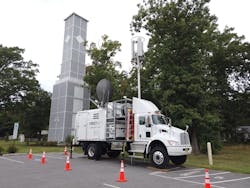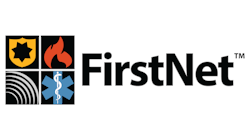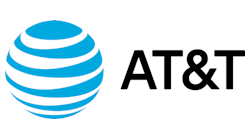FirstNet is a public-private partnership and the only broadband network that’s designed and dedicated to serve public safety. It comprises two separate entities: the federal agency that’s known as the First Responder Network Authority, or FirstNet Authority for short, and FirstNet Built by AT&T, which is the private sector wireless carrier that’s responsible for network build out.
For the network to be functional, it requires a diverse field of FirstNet-certified devices and innovative supporting apps.
FirstNet Authority
FirstNet was created in 2012 as part of the Middle Class Tax Relief and Job Creation Act, in response to recommendations that were made in the 9/11 Commission Report. The legislation created the FirstNet Authority, the mission of which is to develop, build and operate a broadband network that’s dedicated to the nation’s first responders.
The FirstNet Authority (FirstNet.gov) is required to consult with federal, state, tribal and local public safety organizations across the country to ensure that the FirstNet network meets the needs of public safety and realizes its operational benefits.
The first step in regard to the latter was the issuance of a competitive request for proposals (RFP) for deployment of the network. After thorough review, FirstNet awarded a 25-year contract to AT&T in March 2017. Several companies responded to the RFP, but AT&T was the only national wireless carrier to submit a proposal.
The FirstNet Authority then began to chart the next direction for FirstNet by publishing “A Roadmap for Transforming Public Safety Communications.” Framed in collaboration with public safety, the roadmap guides the growth, evolution and advancement of FirstNet. It will be an evolving document that will be updated regularly to ensure implementation of the latest technology for public safety. The roadmap focuses on FirstNet’s core, situational awareness, secure information exchange, coverage and capacity, voice communications and user experience. It will advance the FirstNet experience through investments, public safety policies and procedures, the network’s technology ecosystem and FirstNet Authority/AT&T partnership activities.
In March 2018, AT&T began the build out of FirstNet (FirstNet.com) under a contract that created a public-private partnership. The network is the only nationwide public safety wireless broadband network that has a separate physical and dedicated public safety core (not virtual). The dedicated core provides the highest security standards to ensure that sensitive data are protected and can be shared to responders and organizations that have the appropriate credentials. The network/dedicated core also ensures priority and preemption access to first responders, which means that whenever public safety has a need to communicate, responders have priority over all other customers. The network supports expanding coverage areas, increased capacity, enhanced awareness, an innovative ecosystem, response to disasters, innovation and specialized training/support and network availability of 99.99 percent.
In December 2019, FirstNet hit 1 million connections, serving more than 10,000 public safety agencies nationwide. Momentum continues by ensuring no throttling for FirstNet subscribers, 24/7/365 (always on) priority and preemption for responders. FirstNet Band 14 is live in 675 markets. FirstNet LTE coverage was increased by more than 50,000 square miles in 2018, with prioritized access on all AT&T LTE bands.
The latest progress reports indicate that FirstNet has: more than 1.2 million connections; 11,000 public safety agencies and organizations on the network; more than 100 apps; more than 100 FirstNet-ready devices; 2.61 million square miles of LTE coverage nationwide; 75 percent Band 14 coverage (ahead of schedule); and 76 dedicated deployable network assets, including three Satellite Cells on Wings, an aerostat (lighter-than-air aircraft) and 72 pre-positioned Satellite Cells on Light Trucks, or SatCOLTs. FirstNet also implemented the FirstNet Response Operations Group, which is led by former first responders, to work with agencies to determine appropriate solutions based on the situation.
During the COVID-19 pandemic, FirstNet helps in the following ways: mobile hotspots, satellite phones, Wi-Fi LAN cards, single-use tablets for quarantined areas, Cradlepoint routers, rapid deployment kits, scale bandwidth for remote workers, enhanced push-to-talk (PTT) pager replacement, supply/asset tracking and telemedicine visits with collaborative tools. Real-time COVID-19 use cases include triage/testing facilities, remote workers and Wi-Fi devices, virtual care, clinician shifts, and enhanced collaboration and data.
FirstNet-ready devices
Fortunately, and surprising to some, there is an impressive collection of more than 100 FirstNet-ready devices that have Band 14, which include products from most of the prominent and popular smartphone/tablet manufacturers as well as computer manufacturers. This includes Android, Apple iOS and Microsoft devices. (For a full list of FirstNet-ready devices, visit FirstNet.com.) Companies that provide more than three FirstNet-ready smartphones/devices include Apple (11), Cradlepoint (12), Dell (9), LG (9), Panasonic (4), Pepwave (11), Samsung (23) and Zebra Technologies (6).
Cradlepoint (and AT&T)
This provides a quick-to-deploy, all-inclusive, pop-up network solution for organizations that are on the front lines. It combines the FirstNet network with the Cradlepoint all-in-one FirstNet-ready wireless network solution for Wi-Fi and Ethernet users/devices, which all can be combined to provide critical communications at pop-up sites.
Deployed in several remote operations in support of COVID-19 efforts, it also is used in ambulance mobile care, utilizing a laptop, tablet, on-board Wi-Fi, pulse & oxygen sensor, EKG and automatic vehicle location integration (utilizing a Cradlepoint LTE router). It provides immediate connectivity to medical centers.
Note: Cradlepoint’s FirstConnect Program includes grants, training for IT and operational staff and priority support access 24/7.
Sonim Technologies
This company was one of the early adopters of FirstNet and delivered one of the first FirstNet-certified devices. Its equipment is ultra-ruggedized (to meet military specs), drop/shockproof, dustproof, temperature-resistant and waterproof. The devices are said to be easy to disinfect, particularly for COVID-19. The XP8 smartphone includes a dedicated PTT SOS button and noise-cancellation technology. The XP5 has large tactile buttons, PTT and multishift (long-lasting) batteries.
Samsung
Samsung was another early adopter. Its FirstNet-ready smartphones and devices include the Galaxy Note 10, Note 10+, S9, S9+, S10, S10+, A6, J3, J7, Tab A, Tab S4 and XCover FieldPro. The Galaxy S10 and S10+ support field operations and investigators via extended battery life, large-capacity storage, multiple camera focal lengths, defense-grade security and an ultrasonic fingerprint reader. The larger screen of the Galaxy Note 10 and 10+ is capable of displaying two apps simultaneously. The Galaxy XCover FieldPro includes PTT capability and is said to keep information compliant and secure. Military-spec design withstands drops, shocks and vibration, extreme temperatures, rain, blowing dust and submersion in five feet of water for up to a half-hour.
Apps
Having FirstNet-ready smartphones/devices is important, but the real value doesn’t come until there are meaningful apps for critical functionality. All of the apps that are in the App Catalog are inspected to ensure that they are relevant, reliable and highly secure. Furthermore, FirstNet-certified apps go through a higher degree of security screening and vetting.
First responder activities and functionality covered include: land mobile radio (LMR) augmentation; automation and simplification of administrative tasks; and actionable information-sharing directly with on-scene responders.
To make the catalog more helpful, apps are grouped by three key objectives:
- Enable responder mobility and operational readiness that can be downloaded and used on FirstNet-ready devices.
- Enhance operational capacity and mission execution.
- Grow situational awareness and engage the community.
The catalog also is divided into Mobility Fundamentals, Mission Support and Situational Awareness. Mobility Fundamentals is subdivided into FirstNet Service, Endpoint Security and Communication. Mission Support is subdivided into Core Mission, Responder Resources and Training/Education. Situational Awareness is subdivided into External Awareness, Public Engagement and Operating Picture.
A good start
Other wireless carriers might say that they have a network that’s dedicated to public safety, but FirstNet is the only nationwide wireless broadband network that has a dedicated physical public safety core that’s designed by public safety for public safety. It is a remarkable achievement, but there is much more to come.

Charles Werner
CHARLES WERNER, who is a Firehouse contributing editor, is a 45-year veteran of public safety. He served with the Charlottesville, VA, Fire Department for 37 years, serving the past 10 years as chief. Following retirement, Werner served for two years as senior adviser and acting deputy state coordinator for the Virginia Department of Emergency Management. He has chaired: DHS SAFECOM Executive Committee; IAFC Technology Council; National Information Sharing Consortium; and DHS/White House Incident Management Information Sharing SubCommittee. Werner currently serves as the director of DroneResponders Public Safety Alliance, chair of the National Council on Public Safety UAS and chair of the Virginia Secure Commonwealth UAS Sub Panel.









